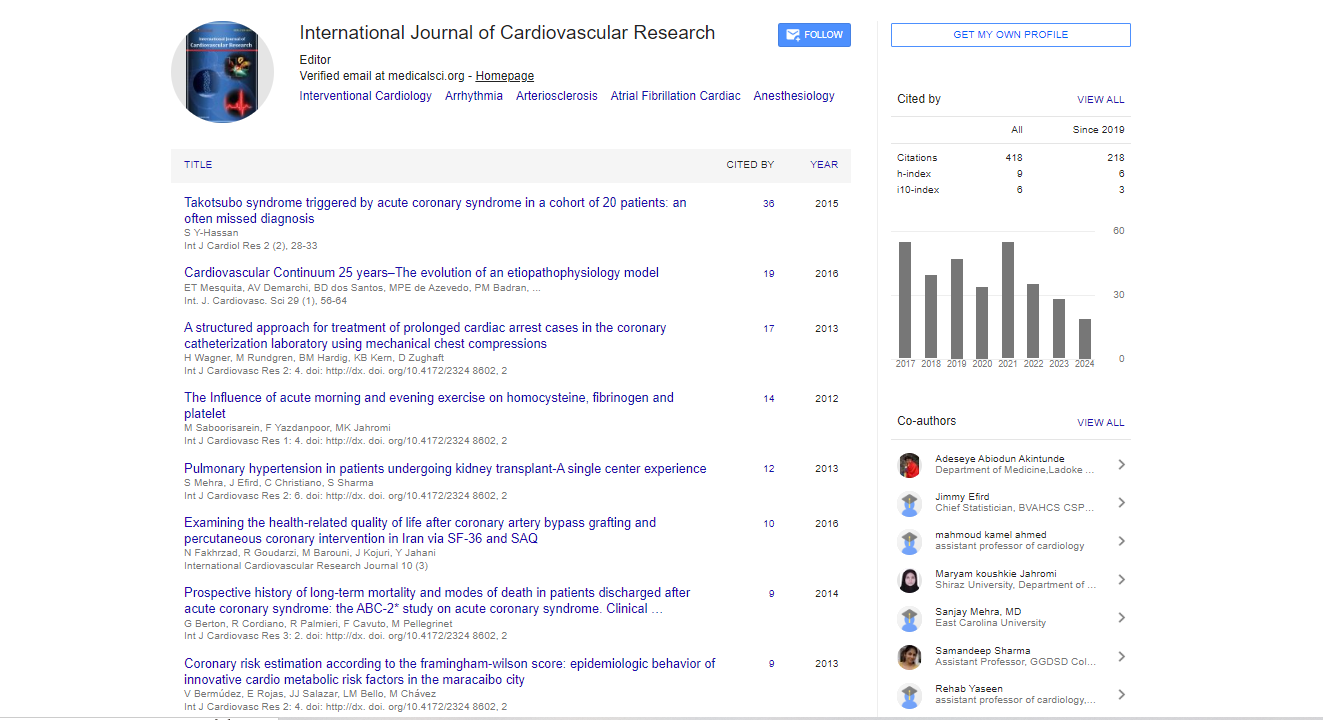Research Article, Int J Cardiovasc Res Vol: 5 Issue: 2
Assessment of Left Atrial Ejection Force in Patients with different Grades of Left Ventricular Diastolic Dysfunction
| Ahmed Mohamed El Missiri*, Sameh Samir Raafat and Mohamed Ismail Ahmed | |
| Cardiology Department, Faculty of Medicine, Ain Shams University, Cairo, Egypt | |
| Corresponding author : Ahmed Mohamed El Missiri Cardiology Department, Faculty of Medicine, Ain Shams University, Abbassia Square, Abbasia 11566, Cairo, Egypt Tel: +20-10-0161-4717 E-mail: amissiri@med.asu.edu.eg; amissiri@yahoo.com |
|
| Received: January 23, 2016 Accepted: February 08, 2016 Published: February 15, 2016 | |
| Citation: Missiri AME, Raafat SS, Ahmed MI (2016) Assessment of Left Atrial Ejection Force in Patients with different Grades of Left Ventricular Diastolic Dysfunction. Int J Cardiovasc Res 5:2. doi:10.4172/2324-8602.1000256 |
Abstract
Assessment of Left Atrial Ejection Force in Patients with different Grades of Left Ventricular Diastolic Dysfunction
Objective: To assess left atrial ejection force (LAEF) in patients with different grades of left ventricular (LV) diastolic dysfunction compared to traditional Doppler and tissue Doppler measurements.
Methods: 120 patients enrolled into four equal groups (n=30), each group represented a different grade of LV diastolic dysfunction and 30 subjects with normal diastolic function. We assessed echocardiographic measurements of dimensions and diastolic function, LA volume index (LAVI), and LAEF and age-corrected %LAEF.
Results: In comparison to control subjects, the study group had more diabetic and hypertensive patients, increased all LV dimensions, estimated LVEDP (p<0.0001), LAVI (p<0.0001), LAEF and %LAEF (p<0.0001). On comparing different grades of diastolic dysfunction, patients with worse grades of diastolic dysfunction were older, more hypertensive and diabetic. They had larger LV dimensions, estimated LVEDP (p<0.0001), and LAVI (p<0.0001). LAEF and %LAEF showed an increase from grade I (8.84 ± 3.09 Kdynes, 188.93 ± 40.12%) to Ia (10.66 ± 3.10 Kdynes, 239.7 ± 72.45%) to II (11.82 ± 45.9 Kdynes, 256.57 ± 45.92%) then demonstrated a significant reduction in grade III to 2.77 ± 1.71 Kdynes, 57.88 ± 32.49% (p<0.0001) dropping below normal values seen in the control subjects (4.98 ± 1.72 Kdynes, 93.30 ± 9.31%) (p<0.0001). Linear regression analysis showed factors affecting %LAEF were: age, E-wave velocity, average e’ velocity, E/A ratio and E/e’ ratio.
Conclusions: LAEF is generally increased in patients with LV diastolic dysfunction compared to those with normal diastolic function. Patients in grade III diastolic dysfunction show marked impairment of LAEF dropping below those with normal diastolic function.
 Spanish
Spanish  Chinese
Chinese  Russian
Russian  German
German  French
French  Japanese
Japanese  Portuguese
Portuguese  Hindi
Hindi 



